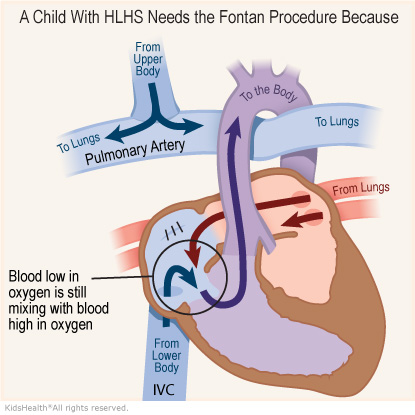- Parents Home
- Para Padres
- A to Z Dictionary
- Allergy Center
- Asthma
- Cancer
- Diabetes
- Diseases & Conditions
- Doctors & Hospitals
- Emotions & Behavior
- First Aid & Safety
- Flu (Influenza)
- Food Allergies
- General Health
- Growth & Development
- Heart Health & Conditions
- Homework Help Center
- Infections
- Newborn Care
- Nutrition & Fitness
- Play & Learn
- Pregnancy Center
- Preventing Premature Birth
- Q&A
- School & Family Life
- Sports Medicine
- Teens Home
- Para Adolescentes
- Asthma
- Be Your Best Self
- Body & Skin Care
- Cancer
- Diabetes
- Diseases & Conditions
- Drugs & Alcohol
- Flu (Influenza)
- Homework Help
- Infections
- Managing Your Weight
- Medical Care 101
- Mental Health
- Nutrition & Fitness
- Q&A
- Safety & First Aid
- School, Jobs, & Friends
- Sexual Health
- Sports Medicine
- Stress & Coping
The Fontan Procedure
What Is the Fontan Procedure?
The Fontan procedure is a type of open-heart surgery. Children who need this surgery usually have it when they’re 18–36 months old.
Why Is the Fontan Procedure Done?
The Fontan procedure is done for children who are born with heart problems like hypoplastic left heart syndrome (HLHS), tricuspid atresia, and double outlet right ventricle.
Depending on the heart problem, children may need the Norwood procedure and Glenn procedure before the Fontan surgery.
What Does the Fontan Procedure Do?
Normally, the right ventricle pumps blood to the lungs to get oxygen, and the left ventricle pumps the blood with oxygen to the body. But in some types of heart problems, one ventricle is too small. Then, the other ventricle not only has to pump blood to the lungs, but also to the body. And the blood that it pumps to the body is a mix oxygen-rich blood and oxygen-poor blood. The body can’t thrive if it doesn’t get enough oxygen.
After the Fontan procedure, the blood from the lower body goes directly to the lungs. The blood with high oxygen goes into the heart. This way the single ventricle:
- only pumps blood to the body
- only pumps blood with high oxygen to the body
There is no more mixing of oxygen-rich blood and oxygen-poor blood.

What Happens During the Fontan Procedure?
During the Fontan procedure, the surgeon:
- Disconnects the inferior vena cava (IVC) from the heart and connects it to the pulmonary artery using a conduit (tube).
- Makes a small hole between the conduit and the right atrium. This hole (or fenestration) lets some blood still flow back to the heart. It prevents too much blood from flowing to the lungs right away so they have time to adjust. Doctors can close the fenestration later by doing a cardiac catheterization procedure.

What Happens After the Fontan Procedure?
Children who have the Fontan procedure usually spend 1 to 2 weeks in the hospital to recover. They get round-the-clock care and monitoring. They also get medicines to help the heart and improve blood flow. They will keep taking some of these medicines at home.
During this time, the care team teaches parents how to care for their child at home. Children usually can go home when they are feeding well, growing well, and gaining weight.
Many children thrive and do well after heart surgery. They'll need to see a cardiologist regularly get EKGs, echocardiograms, lab tests and occasional cardiac catheterizations. A cardiac catheterization is a procedure that lets cardiologists check how the heart is working and do some types of treatments.

How Can Parents Help?
At home with your child, follow the care team’s instructions about:
- giving any medicines
- going to follow-up doctor visits
- looking for blueness of the lips or nails
Call your surgeon or care team if you have any questions about how to care for your child after surgery.
When Should I Call the Doctor?
Call the care team right away if your child:
- is not eating
- is vomiting
- seems to be breathing fast or working hard to breathe
- oxygen levels drop lower than usual
- seems very irritable
- just doesn't seem quite right
What Else Should I Know?
Caring for a child after heart surgery can be overwhelming for any family. But you’re not alone. The doctors, nurses, social workers, and other members of the care team are there to help you and your child.
It can help to find a support group for parents whose kids have a serious heart condition. Ask the care team for recommendations. You also can find support and more information online at: